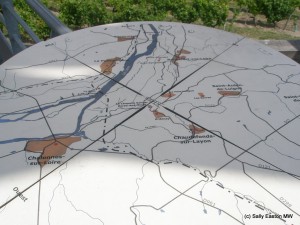Crus de Loire

Loire tributary, the Layon
The Loire valley has begun to break with its long tradition of a single-ranking, single-level appellation system. In 2011 it started to evolve a cru system of appellations. Such a single ranking appellation system, across some 70-odd appellations along the long Loire valley was, for example, totally unlike Burgundy’s vineyard classification via its hierarchy of appellations from basic Bourgogne, through village and premier cru to grand cru, and unlike Bordeaux’s classification system which overlays the appellations in that region. In the Loire there was just a series of different appellations without any integral quality statement. This is not to say these things have happened overnight – such fundamental changes can take years of discussion and negotiation.
In 2011 Muscadet introduced their first communal cru appellations. The three crus of Clisson, Gorges and Le Pallet, each named after their specific geographical location, were approved, with another four locations potentially identified. Clisson is on granite; Gorges on quartz and gabbro, and Le Pallet on gneiss and gabbro. Unlike Muscadet de Sèvre et Maine sur lie, which must be bottled at specific points in the year after the harvest, the communal crus have minimum ageing times of 18 months and more.
At the end of 2011, another two cru appellations, both in Anjou, were passed into law. Quarts de Chaume became a Grand Cru appellation, and Coteaux du Layon Chaume became a Premier Cru appellation.
Quarts de Chaume is a 50 hectare appellation on schist around the village of Chaume, recognised since 1954. Grand Cru can be added to the name from the 2010 vintage, making it the Loire’s first Grand Cru. The new Coteaux du Layon Premier Cru Chaume is adjacent to Quarts de Chaume.
Both these appellations lie within the bigger, straightforward Coteaux du Layon appellation which covers some 1,400 hectares, all on the banks of the river Layon, a tributary of the river Loire.
Sweet wines, often but not exclusively with botrytis, from chenin blanc, are the preserve of all three appellations. A clear, quality-suggestive hierarchy has been instigated, though as with these things, quality is so often at the behest of the individual producer. Such things as permitted yields, grape ripeness on harvest, the banning of chaptalisation, and the phasing out of cryoextraction are all legislated.
The introduction, even on such an ad hoc basis, of the beginnings of an appellation hierarchy in the Loire valley is a huge departure from its previously egalitarian foundation, but fits with that most French of concepts – terroir – that one patch of land can produce distinctive and different wines from another patch.
Comments
2 Responses to “Crus de Loire”




September 25, 2020 at 8:01 am
I have read a few articles on the Quarts de Chaume and the Coteaux de Layon wines getting their cru status – but have you read or heard of any others in the Chinon or Saumur region doing the same? Are you aware of any plans in the pipeline? Would be interested as I live right in amongst the vines and would be interested. I have found some very distinct regions that are of a much higher quality than the others for sure – around Puy de Notre Dame and Montreuil-Bellay as just one example.
September 27, 2020 at 3:50 pm
You could follow http://jimsloire.blogspot.com/ for more regular wine info than I offer.